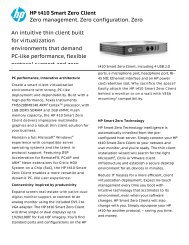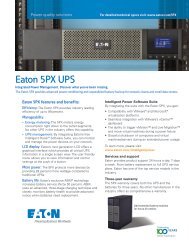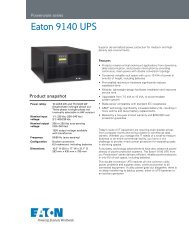Parallel UPS configurations - Eaton Corporation
Parallel UPS configurations - Eaton Corporation
Parallel UPS configurations - Eaton Corporation
You also want an ePaper? Increase the reach of your titles
YUMPU automatically turns print PDFs into web optimized ePapers that Google loves.
Selective tripping—identifying and temporarily isolating a <strong>UPS</strong> with a problemWhen <strong>UPS</strong> modules are paralleled, it can be difficult to identify the root cause of a failure. Youmight see a drop in voltage on the shared output bus, but which <strong>UPS</strong> is the culprit? You need tofind out which module is causing the problem, and isolate it quickly before it drags down othermodules and causes the whole system to switch to bypass mode.In a conventional parallel <strong>UPS</strong> configuration…A faulty module may be signified by the whole system going to bypass. Though most modulefailures are benign, a failed inverter IGBT or shorted capacitor may appear as a fault on thecritical bus. For this type of failure, it could be difficult to quickly identify the root cause andremove the failed module from the critical bus. The system could go to bypass, leaving loadsexposed to straight utility power for as long it takes for service to arrive.In a more resilient parallel <strong>UPS</strong> configuration…Each module need only look at itself to see if it has failed. An algorithm assesses thedifference in current/voltage in each phase and detects failures based on a running record ofthis information—continually comparing present waveforms with previously recordedwaveforms. Based on this high-speed calculation, the unit detects a fault even before typicalhardware sensors would detect it. The affected <strong>UPS</strong> module turns off its inverter IGBTtransistors within microseconds (millionths of a second). The result is a selective trip thatinstantly isolates the faulty unit from the system until the problem can be resolved.Since this process does not require communication links among modules, the module is swiftlyremoved from the critical bus before the problem can affect critical loads and before the systemsees the need to go to bypass.Design for reliabilityRedundant <strong>UPS</strong> <strong>configurations</strong> are a necessity to meet the uptime requirements of a 7/24world—and paralleling is a key way to maximize that uptime. However, when two or more ACpower sources are joined in parallel, you may solve one problem while potentially creating others,for all the reasons described earlier.Most parallel technologies on the market can adequately meet the needs for synchronization,load-sharing and selective tripping—but if you look closely at how they perform these functions,you’ll see big differences in potential reliability on several key dimensions:• Autonomy—Can the system successfully operate without external controls and monitoring?• Complexity—How many components, connections and negotiated interfaces are required?• System wiring—Is there a complex and vulnerable mesh of communication wires betweenmodules?This last element has proven to be the weakest link in conventional parallel systems, whichrequire a great deal of control wiring between modules and sometimes between modules and thebypass cabinet. A typical arrangement has a set of wires for synchronizing each phase andneutral, another set of wires for load-sharing, and yet another set of wires to control the selectivetripping process. Very quickly this architecture yields a huge bundle of control wires that aredevilish to troubleshoot.WP09-02 www.eaton.com/powerquality January 2009 - 7
















